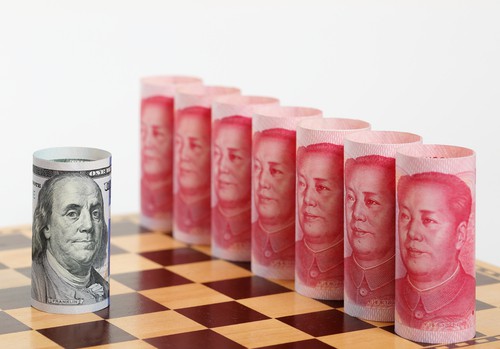 Financial markets across the board have been rocked by Chinese instability in the first two weeks of 2016, sending Chinese equities below where they bottomed last August. A main cause of this volatility is the lack of confidence in the competence and true agenda of Chinese officials regarding the devaluation of the offshore yuan in the face of achieving inclusion into the IMF’s Special Drawing Rights or SDR.
Financial markets across the board have been rocked by Chinese instability in the first two weeks of 2016, sending Chinese equities below where they bottomed last August. A main cause of this volatility is the lack of confidence in the competence and true agenda of Chinese officials regarding the devaluation of the offshore yuan in the face of achieving inclusion into the IMF’s Special Drawing Rights or SDR.
The Chinese at the time, were adamant that a large scale devaluation was not in the cards. However speculation that large capital outflows will pressure the Chinese regime to devalue anyway have caused a sell first and ask questions later mentality. Here is a portion of a statement they issued regarding the devaluation speculation at the time of the IMF’s decision to include the yuan.
The abundant foreign exchange reserves, the sound fiscal standing and a robust financial system jointly provide a solid foundation for the RMB exchange rate to remain basically stable at an adaptive and equilibrium level.
The problem is that no one really trusts what the Chinese government is saying anymore; and, they really don’t trust that the know what they are doing when it comes to regulating and monitoring financial markets.Circuit breakers were imposed on the equity markets after the summer machinations that caused great anxiety in Beijing and across the world, only to be removed recently when they were found to be hindering market performance rather than stabilizing it. All this episode did was to inject fear into the markets.
It’s no secret that the Chinese economy is slowing, maybe even drastically. Some believe that China could experience a full blown currency crisis that could wipe out their massive foreign currency reserves. The wealthy Chinese are taking their money out of an unstable China in boatloads. This end-game scenario seems highly improbable but the there is cause to worry about where the Chinese officials are taking their financial system.
Today, Bloomberg reported that China will increase offshore bank yuan reserve levels to match those of domestic banks starting January 25th of this year. This is being done to prevent arbitrage between the two versions of the renminbi and to support the view that the yuan is truly ‘freely usable’ as per the requirements of the IMF. The gap between the onshore and offshore currency had grown too large to support that perception and ran the risk of the world seeing an official devaluation underway to promote economic growth through the export market. This perception would likely increase volatility in the equity markets and increase the chances of a full blown conflagration.
So to answer the devaluation question, the most likely pathway for the Chinese government is to attempt to maintain a fairly stable ‘range’ in regards to the yuan’s valuation against a basket of global reserve currencies. This most likely will require government intervention to support the yuan to maintain an appropriate level, which means using more foreign reserves.
The one variable that the markets would like to have answered is whether or not China has the skill to manage this domestic downturn while at the same time living up to its commitments to the IMF and its reputation as a large, critical economy on the global stage.
On Tuesday morning of next week, China will release critical economic data that should shed some light on the situation in-country. Unfortunately, now the world will have real doubt about the veracity of the numbers. It will take China a long time to earn the respect and trust of the global economy once again after the last year of financial stress.
L. Todd Wood is a former emerging market debt trader with 18 years of Wall Street and international experience. He is also an author of historical fiction thriller novels. His first of several books, Currency, deals with the consequences of overwhelming sovereign debt. He is a contributor to many media outlets and is a foreign correspondent for Newsmax TV. LToddWood.com





